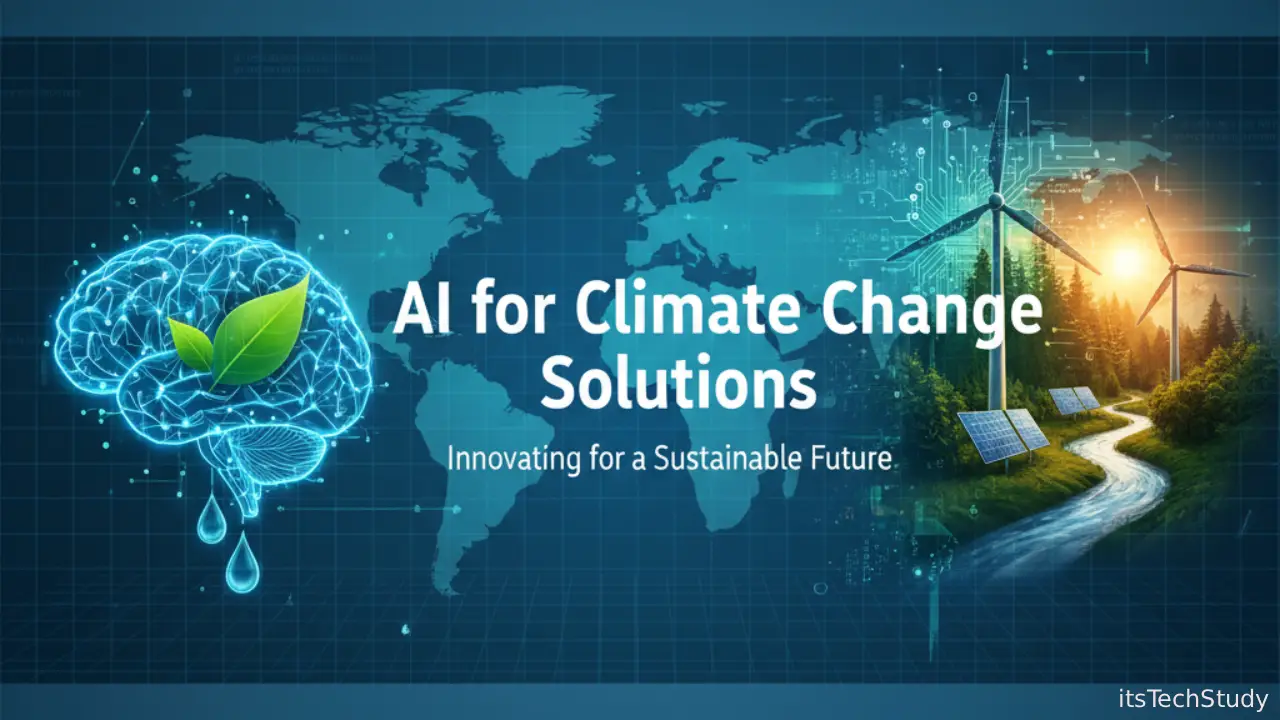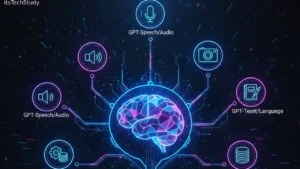Introduction: The Tech Frontier of Climate Action
For decades, humanity has battled the mounting threat of climate change – rising global temperatures, melting glaciers, erratic weather patterns, and increasing natural disasters. Despite countless global efforts, the climate crisis continues to intensify, demanding faster, smarter, and more innovative approaches.
Enter Artificial Intelligence (AI) – one of the most transformative technologies of our time. From optimizing renewable energy systems to predicting extreme weather events, AI for climate change solutions is reshaping how we understand, respond to, and mitigate environmental challenges.
Today, tech professionals, environmentalists, and policymakers are realizing that AI isn’t just about automation or smart devices – it’s a powerful ally in saving our planet. Let’s explore how AI is leading the fight for a greener future and why this integration of technology and sustainability is more critical than ever.
Understanding the Role of AI in Climate Change Solutions
AI, with its ability to analyze massive datasets, recognize patterns, and make predictions, has become a game-changer for environmental science. Traditional climate research took years to process vast volumes of atmospheric, oceanic, and temperature data – AI now does that in days or even hours.
This efficiency opens new opportunities for scientists and engineers to develop proactive strategies for mitigating the impact of climate change. The applications of AI span across energy management, agriculture, disaster prediction, carbon tracking, and ecosystem restoration.
How AI Transforms Climate Science
- Data Analysis & Prediction: Machine learning algorithms process satellite and sensor data to detect environmental changes early.
- Automation of Climate Models: AI accelerates climate simulations, offering more precise forecasts.
- Resource Optimization: AI optimizes water usage, electricity distribution, and crop growth to reduce emissions.
These advancements enable humanity to act faster, make smarter decisions, and craft policies that are backed by data – not assumptions.
Key Areas Where AI Fights Climate Change
Let’s dive deeper into how AI is creating measurable impact across various sustainability sectors.
1. Renewable Energy Optimization
AI-driven systems help balance supply and demand in renewable energy grids. For example, Google’s DeepMind has successfully improved wind energy forecasting, increasing operational efficiency by over 20%.
AI models analyze weather patterns to predict solar and wind power generation, allowing energy providers to plan storage and distribution better.
Benefits:
- Reduced energy waste
- Enhanced grid stability
- Lower carbon emissions
Example: Tesla’s AI-based energy management in Powerwall and Powerpack systems ensures maximum use of clean energy sources.
2. Climate Forecasting and Disaster Prediction
AI excels at predicting extreme weather events like hurricanes, floods, and heatwaves. By training neural networks on decades of meteorological data, scientists can issue early warnings and help communities prepare in advance.
This predictive capability not only saves lives but also minimizes economic losses.
Real-World Example: IBM’s Environmental Intelligence Suite uses AI to analyze satellite imagery and alert governments about potential climate threats.
3. Sustainable Agriculture and Food Systems
Agriculture contributes significantly to greenhouse gas emissions. AI helps farmers adopt more sustainable practices through precision agriculture — using sensors, drones, and algorithms to optimize crop yields while conserving water and soil nutrients.
AI Applications in Agriculture:
- Predicting soil health and moisture levels
- Detecting crop diseases early
- Optimizing fertilizer and pesticide use
- Enhancing food distribution efficiency
The result: higher productivity with a smaller carbon footprint.
4. AI in Carbon Capture and Climate Modeling
Carbon capture and storage (CCS) systems are crucial for reducing emissions from industries. AI helps optimize these systems by analyzing factors such as pressure, temperature, and flow rates to maximize CO₂ absorption efficiency.
AI also enhances climate modeling – enabling researchers to simulate potential future climate scenarios under various emission policies.
| AI Application | Function | Impact on Climate Change |
|---|---|---|
| Predictive Climate Models | Simulates temperature rise, sea-level change | Better policy-making and adaptation strategies |
| Carbon Emission Tracking | Monitors industrial emissions in real time | Transparency and accountability for carbon reduction |
| AI-Driven CCS Optimization | Improves carbon absorption and energy use | Efficient emission control |
| Renewable Grid Balancing | Predicts demand and adjusts renewable output | Reduced energy waste |
5. AI in Smart Cities and Transportation
Urban areas are responsible for over 70% of global CO₂ emissions. AI is enabling smart city development through intelligent traffic management, energy-efficient buildings, and waste reduction technologies.
For instance, AI-controlled traffic systems reduce congestion and fuel consumption by adapting signal patterns to real-time traffic data.
In transportation, AI optimizes routes for logistics companies, minimizing emissions and improving delivery speed.
Pros of AI in Smart Cities:
- Reduced fuel waste
- Improved air quality
- Lower operational costs
- Data-driven urban planning
Cons:
- High implementation costs
- Privacy concerns with urban data collection
- Dependence on reliable digital infrastructure
Advantages and Challenges of Using AI for Climate Change
Like any technological revolution, integrating AI into climate solutions brings both opportunities and challenges.
Pros
- High Efficiency: Processes vast data quickly for accurate predictions.
- Better Decision-Making: Data-backed insights guide smarter environmental policies.
- Resource Optimization: Reduces waste in agriculture, energy, and manufacturing.
- Automation of Complex Systems: Allows continuous monitoring and adaptation.
- Scalable Impact: AI can be applied globally across multiple sectors.
Cons
- Energy Consumption: Training large AI models requires significant computational power.
- Data Bias: AI is only as accurate as the data it learns from.
- Cost of Implementation: Developing and deploying AI systems can be expensive.
- Privacy Risks: Environmental and urban data may expose sensitive information.
- Need for Expertise: Skilled professionals are required to maintain AI systems.
Steps to Implement AI for Climate Action
If you’re a tech professional, organization, or policymaker looking to integrate AI-driven climate strategies, here’s a simple roadmap:
- Identify the Problem Area – Focus on high-impact zones like energy, transport, or agriculture.
- Collect Quality Data – Use reliable sensors, satellite imagery, or open data sources.
- Choose the Right AI Model – Machine learning, neural networks, or reinforcement learning based on the problem scope.
- Collaborate with Experts – Partner with climate scientists, data engineers, and sustainability experts.
- Monitor and Improve – Continuously analyze outcomes and fine-tune your AI algorithms.
- Ensure Ethical AI Usage – Maintain transparency, fairness, and sustainability in data handling.
Real-World Examples of AI Driving Climate Innovation
- Microsoft’s AI for Earth: Provides tools and funding to projects using AI to solve global environmental issues.
- Google Earth Engine: Uses AI to monitor deforestation and water changes.
- IBM Green Horizon: AI-powered analytics to reduce pollution and improve air quality forecasts.
- Climate TRACE: A coalition using AI and satellite data to track global greenhouse gas emissions in near real-time.
These initiatives demonstrate that AI is no longer theoretical – it’s a practical tool for building a resilient, eco-conscious future.
Conclusion: A Smarter Future for a Sustainable Planet
Artificial Intelligence has moved from the realm of innovation to the frontline of climate action. It’s optimizing renewable energy, predicting disasters, supporting sustainable agriculture, and empowering smart cities to function efficiently.
However, the success of AI in combating climate change depends on ethical usage, cross-industry collaboration, and continued innovation. As tech professionals, the responsibility lies in ensuring these tools serve both progress and the planet.
With every algorithm, model, and innovation, AI brings us closer to a smarter, cleaner, and greener world – proving that technology, when guided by purpose, can indeed help save the Earth.
Frequently Asked Questions (FAQ)
Q1: How exactly does AI help in fighting climate change?
Ans: AI helps by analyzing climate data, predicting environmental changes, optimizing renewable energy usage, reducing emissions, and improving sustainability in agriculture, industry, and cities.
Q2: Is AI environmentally friendly?
Ans: AI’s environmental friendliness depends on how it’s used. While training models consumes energy, AI-driven optimizations often lead to overall emission reductions, balancing the footprint.
Q3: What industries benefit most from AI climate applications?
Ans: Energy, agriculture, manufacturing, logistics, and construction are leading beneficiaries. AI enables them to operate efficiently with minimal environmental impact.
Q4: Can AI predict natural disasters accurately?
Ans: Yes, AI models trained on historical meteorological and geological data can forecast floods, hurricanes, and droughts with high accuracy, allowing timely preventive measures.
Q5: What are the ethical challenges of using AI in environmental solutions?
Ans: Concerns include data privacy, algorithmic bias, and unequal access to AI tools. Addressing these requires transparent frameworks and inclusive innovation.
Q6: What is the future of AI in climate technology?
Ans: The future lies in AI-driven climate adaptation, real-time environmental monitoring, and autonomous renewable systems that can learn and self-optimize for global sustainability.












No Comments Yet
Be the first to share your thoughts.
Leave a Comment